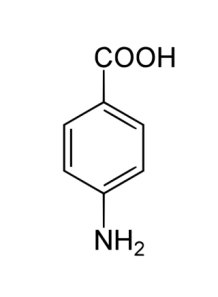4-Aminobenzoic acid (PABA)
sometimes incorrectly referred to as Vitamin Bx, is an organic compound. While it is an essential nutrient for some bacteria (as an intermediate in folate synthesis)
sometimes incorrectly referred to as Vitamin Bx, is an organic compound. While it is an essential nutrient for some bacteria (as an intermediate in folate synthesis)
Para-aminobenzoic acid (PABA), sometimes incorrectly referred to as Vitamin Bx, is an organic compound. While it is an essential nutrient for some bacteria (as an intermediate in folate synthesis), it is not considered a vitamin for humans as we obtain folate directly from our diet and cannot synthesize it using PABA.
Historically and currently, PABA and its derivatives have been investigated for various health applications, but robust scientific evidence for many claimed benefits is limited or lacking.
Here's a breakdown of potential uses and the associated research:
-
Sun Protection (Topical Use):
- Claim: PABA and its ester derivatives were among the first effective chemical agents used in sunscreens because they strongly absorb UVB radiation.
- Evidence: PABA's ability to absorb UVB is well-established. However, its use in sunscreens has significantly declined due to concerns about allergic reactions (contact dermatitis) and photosensitivity in some individuals. It has largely been replaced by other UV-filtering agents.
- Citation: While specific citations for its basic UV absorption are foundational chemistry, reviews on sunscreen history and ingredients discuss its rise and fall. (e.g., History of Sunscreens. J Am Acad Dermatol. 2001; Update on sunscreen safety and effectiveness. Cleve Clin J Med. 2021)
-
Skin Conditions (Oral Use - often as Potassium Para-aminobenzoate, Potaba):
- Peyronie's Disease: This condition involves fibrous scar tissue forming in the penis. Potassium para-aminobenzoate (Potaba) has been studied as a treatment.
- Claim: Potaba may help soften fibrous tissue and reduce plaque size or curvature.
- Evidence: Evidence is mixed and controversial. Some older studies suggested benefits, potentially related to antifibrotic effects via increased oxygen uptake by tissues. However, many of these studies had methodological limitations. More recent reviews and guidelines often question its efficacy, especially compared to newer treatments. High doses are typically required, leading to potential gastrointestinal side effects.
- Citations:
- Weidner, W., Hauck, E. W., & Schnitker, J. (2005). Potassium paraaminobenzoate (POTABA) in the treatment of Peyronie's disease: a prospective, placebo-controlled, randomized study. European Urology, 47(4), 515–521. (This randomized controlled trial found no significant benefit over placebo for plaque size or penile curvature).
- Reviews often cite mixed results: e.g., Levine, L. A. (2007). Peyronie's disease: A review. Reviews in Urology, 9(2), 69–78.
- Scleroderma: A chronic autoimmune disease causing hardening and tightening of the skin and connective tissues.
- Claim: Potaba might help soften skin and improve mobility in some forms of scleroderma.
- Evidence: Similar to Peyronie's disease, evidence is largely based on older, often uncontrolled studies or case reports. Its use is not widespread, and robust clinical trial data supporting its effectiveness is lacking. High doses and potential side effects are concerns.
- Citations: Zarafonetis, C. J., et al. (1964). Treatment of scleroderma. Annals of Internal Medicine, 60, 359-369. (Example of older research). Modern reviews often highlight the lack of strong evidence.
- Vitiligo: A condition causing loss of skin pigment in patches.
- Claim: PABA might help with repigmentation, possibly through antioxidant effects or interaction with melanin production.
- Evidence: There is very limited evidence, mostly from older, small studies or anecdotal reports. It is not considered a standard or proven treatment for vitiligo.
- Citation: Generally, modern dermatology reviews do not list PABA as an effective treatment for vitiligo due to insufficient evidence.
- Peyronie's Disease: This condition involves fibrous scar tissue forming in the penis. Potassium para-aminobenzoate (Potaba) has been studied as a treatment.
-
Hair Color Restoration:
- Claim: PABA supplements can prevent or reverse graying hair.
- Evidence: This claim largely stems from early studies in rodents (around the 1940s) and anecdotal human reports. There is no reliable, large-scale human clinical trial evidence demonstrating that PABA supplementation restores hair color. Nutritional deficiencies can sometimes affect hair, but PABA is not established as a factor in typical age-related graying.
- Citation: Sieve, B. F. (1941). Clinical achromotrichia. Science, 94(2437), 257–258. (Example of early, often cited anecdotal work). Lack of subsequent robust human trials is notable.
-
Other Claims: PABA has also been anecdotally linked to benefits for infertility, fatigue, rheumatic fever, and headaches, but there is no significant scientific evidence to support these uses.
| Mechanism | - |
| Appearance | - |
| Longevity | - |
| Strength | - |
| Storage | - |
| Shelf Life | - |
| Allergen(s) | - |
| Dosage (Range) | - |
| Recommended Dosage | - |
| Dosage (Per Day) | - |
| Recommended Dosage (Per Day) | - |
| Mix Method | - |
| Heat Resistance | - |
| Stable in pH range | - |
| Solubility | - |
| Product Types | - |
| INCI | - |
Purchase History for
Cart
No products



